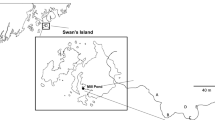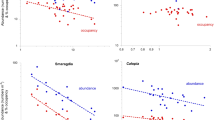Abstract
Sessile biota can compete with or facilitate each other, and the interaction of facilitation and competition at different spatial scales is key to developing spatial patchiness and patterning. We examined density and scale dependence in a patterned, soft sediment mussel bed. We followed mussel growth and density at two spatial scales separated by four orders of magnitude. In summer, competition was important at both scales. In winter, there was net facilitation at the small scale with no evidence of density dependence at the large scale. The mechanism for facilitation is probably density dependent protection from wave dislodgement. Intraspecific interactions in soft sediment mussel beds thus vary both temporally and spatially. Our data support the idea that pattern formation in ecological systems arises from competition at large scales and facilitation at smaller scales, so far only shown in vegetation systems. The data, and a simple, heuristic model, also suggest that facilitative interactions in sessile biota are mediated by physical stress, and that interactions change in strength and sign along a spatial or temporal gradient of physical stress.







Similar content being viewed by others
References
Beadman HA (2003) The sustainability of mussel culture. PhD Thesis, School of Ocean Sciences, University of Wales Bangor, Menai Bridge, Anglesey, UK
Beadman HA, Kaiser MJ, Galanidi M, Shucksmith R, Willows RI (2004) Changes in species richness with stocking density of marine bivalves. J Appl Ecol 41:464–475
Bell EC, Gosline JM (1997) Strategies for life in flow: tenacity, morphometry and probability of dislodgement of two Mytilus species. Mar Ecol Prog Ser 159:197–208
Bertness MD (1989) Intraspecific competition and facilitation in a northern acorn barnacle population. Ecology 70:257–268
Bertness MD, Callaway R (1994) Positive interactions in communities. Trends Ecol Evol 9:191–193
Bertness MD, Ewanchuk PJ (2002) Latitudinal and climate-driven variation in the strength and nature of biological interactions in New England salt marshes. Oecologia 132:392–401
Bertness MD, Grosholz E (1985) Population dynamics of the ribbed mussel, Geukensia demissa: the costs and benefits of a clumped distribution. Oecologia 67:192–204
Bertness MD, Hacker SD (1994) Physical stress and positive associations among marsh plants. Am Nat 144:363–372
Bertness MD, Leonard GH (1997) The role of positive interactions in communities: lessons from intertidal habitats. Ecology 78:1976–1989
Bertness MD, Gaines SD, Yeh SM (1998) Making mountains out of barnacles: the dynamics of acorn barnacle hummocking. Ecology 79:1382–1394
Côté IM, Jelnikar E (1999) Predator-induced clumping behaviour in mussels (Mytilus edulis Linneaus). J Exp Mar Biol Ecol 235:201–211
Caldow RWG, Beadman HA, McGrorty S, Kaiser MJ, Goss-Custard JD, Mould K, Wilson A (2003) Effects of intertidal mussel cultivation on bird assemblages. Mar Ecol Prog Ser 259:173–183
Callaway R (1995) Positive interactions among plants. Bot Rev 61:306–349
Callaway RM, Brooker RW, Choler P, Kikvidzes Z, Lortie CJ, Michalet R, Paolini L, Pugnaire FI, Newingham B, Aschehoug ET, Armas C, Kikodze D, Cook B (2002) Positive interactions among alpine plants increase with stress. Nature 417:844–848
Carrington E (2002) The ecomechanics of mussel attachment: from molecules to ecosystems. Int Comp Biol 42:846–852
Chase J, Leibold M (2002) Spatial scale dictates the productivity-biodiversity relationship. Nature 416:427–430
Couteron P, Lejeune O (2001) Periodic spotted patterns in semi-arid vegetation explained by a propagation-inhibition model. J Ecol 89:616–628
Denny MW, Daniel TL, Koehl MAR (1985) Mechanical limits to size in wave-swept organisms. Ecol Monogr 55:69–102
Frank K, Brickman D (2000) Allee effects and compensatory population dynamics within a stock complex. Can J Fish Aquat Sci 57:513–517
Fréchette M, Aitken A, Page L (1992) Interdependence of food and space limitation of a benthic suspension feeder: consequences for self-thinning. Mar Ecol Prog Ser 83:56–62
Hamer KC, Hill JK (2000) Scale-dependent effects of habitat disturbance on species richness in tropical forests. Conserv Biol 14:1435–1440
Hawkins AJS, Bayne BL (1985) Seasonal variation in the relative utilisation of carbon and nitrogen by the mussel Mytilus edulis: budgets, conversion efficiencies and maintenance requirements. Mar Ecol Prog Ser 25:181–188
Hunt HL, Schiebling RE (2001a) Patch dynamics of mussels on rocky shores: integrating process to understand pattern. Ecology 82:3213–3231
Hunt HL, Schiebling RE (2001b) Predicting wave dislodgement of mussels: variation in attachment strength with body size, habitat and season. Mar Ecol Prog Ser 25:181–188
Kaiser MJ (2003) Detecting the effects of fishing on seabed community diversity: importance of scale and sample size. Conserv Biol 17:512–520
Klausmeier CA (1999) Regular and irregular patterns in semiarid vegetation. Science 284:1826–1828
van de Koppel J, Herman PMJ, Thoolen P, Heip CHR (2001) Do alternate stable states occur in natural ecosystems? Evidence from a tidal flat. Ecology 82:3449–3461
van de Koppel J, Rietkerk M, Dankers M, Herman PMJ (2005) Scale-dependent feedback and regular spatial patterns in young mussel beds. Am Nat 165 (in press)
Levin SA (1992) The problem of pattern and scale in ecology. Ecology 73:1943–1967
Lively CM, Raimondi PT (1987) Desiccation, predation and mussel-barnacle interactions in the northern Gulf of California. Oecologia 74:304–309
McQuaid C, Lindsay T (2000) Effect of wave exposure on growth and mortality rates of the mussel Perna perna: bottom-up regulation of intertidal populations. Mar Ecol Prog Ser 206:147–154
Morgan R, Brown J, Thorson J (1997) The effects of spatial scale on the functional response of fox squirrels. Ecology 78:1087–1097
Newell CR (1990) The effects of mussel (Mytilus edulis Linnaeus 1758) position in seeded bottom patches on growth at subtidal lease sites in Maine. J Shellfish Res 9:113–118
Okamura B (1986) Group living and the effects of spatial position in aggregations of Mytilus edulis. Oecologia 69:341–347
Price HA (1982) An analysis of factors determining seasonal variation in the byssal attachment strength of Mytilus edulis. J Mar Biol Assoc UK 62:147–155
Ray C, Hastings A (1996) Density dependence: are we searching at the wrong spatial scale? J Anim Ecol 65:556–566
Rietkerk M, Boerlijst MC, van Langevelde F, HilleRisLambers R, van de Koppel J, Kumar L, Prins HHT, de Roos AM (2002) Self-organisation of vegetation in arid ecosystems. Am Nat 160:524–530
Rietkerk M, Dekker SC, de Ruiter PC, van de Koppel J (2004a) Self-organised patchiness and catastrophic shifts in ecosystems. Science 305:1929–1929
Rietkerk M, Dekker SC, Wassen MJ, Verkroost AWM, Bierkens MFP (2004b) A putative mechanism for bog patterning. Am Nat 163:699–708
Schneider DC (1994) Quantitive ecology: spatial and temporal scaling. San Diego University Press, San Diego
Smaal A, van Stralen M, Schuiling E (2001) The interaction between shellfish culture and ecosystem processes. Can J Fish Aquat Sci 58:991–1002
Tewksbury JJ, Lloyd JD (2001) Positive interactions under nurse plants: spatial scale, stress gradient and benefactor size. Oecologia 127:425–434
Turing AM (1952) The chemical basis of morphogenesis. Phil Trans Roy Soc Lond B 237:37–72
Underwood AJ (1997) Experiments in Ecology. Cambridge University Press, Cambridge
Williams D, Liebhold A (2000) Spatial scale and the detection of density dependence in spruce budworm outbreaks in eastern North America. Oecologia 124:544–552
Zar JH (1999) Biostatistical analysis. 4th edn. Prentice Hall, Upper Saddle River, New Jersey
Acknowledgements
Thanks to Kim Mould of Myti Mussels for use of the field site and the setting up of the experiment, to Gwynne Parry-Jones and members of CREAM for field work, and to Johan van de Koppel for helpful comments on several drafts. JG and CS are supported by grants from BBSRC and DEFRA and HB was supported by a grant from NERC.
Author information
Authors and Affiliations
Corresponding author
Additional information
Communicated by Martin Attrill
Rights and permissions
About this article
Cite this article
Gascoigne, J.C., Beadman, H.A., Saurel, C. et al. Density dependence, spatial scale and patterning in sessile biota. Oecologia 145, 371–381 (2005). https://doi.org/10.1007/s00442-005-0137-x
Received:
Accepted:
Published:
Issue Date:
DOI: https://doi.org/10.1007/s00442-005-0137-x




